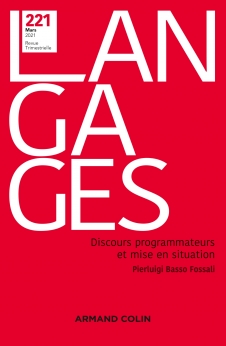
Langages Nº 221 (1/2021)
Pour acheter ce numéro, contactez-nous
Recevez les numéros de l'année en cours et accédez à l'intégralité des articles en ligne.
Lors de la production d’une explication, les locuteurs sont confrontés à une tâche impliquant deux principaux objectifs : (i) la construction référentielle inhérente à l’objet de l’explication et (ii) la gestion de l’interaction et des interlocuteurs. L’objectif de cette étude est ainsi de voir comment une explication procédurale à enjeu interactionnel est gérée par l’enfant et à partir de quand il commence à maîtriser à la fois les contraintes référentielles et pragmatiques de la production langagière. Pour ce faire, des explications d’enfants âgés de 9 à 13 ans ont été collectées et analysées. Les résultats montrent que l’âge a un impact sur les choix informationnels et gestuels des enfants, que ceux-ci s’appuient sur la modalité gestuelle du langage, différemment selon l’âge, et enfin qu’en grandissant, ils améliorent la gestion des contraintes interactionnelles.
When producing an explanation, the speakers are confronted with a task involving two main objectives: (i) the referential construction inherent in the object of the explanation and (ii) the management of the interaction and interlocutors. The objective of this study is to see how a procedural explanation with an interactional issue is managed by the child and from when he begins to master both referential and pragmatic constraints of spoken language production. To do this, explanations of children aged 9 to 13 years were collected and analyzed. The results show that age has an impact on children’s informational and gestural choices, that children rely on the gestural modality of language, differently according to age, and that, as they age, they improve the way they manage interactional constraints.